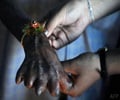An international team of scientists was successful in reconstructing a dozen medieval and modern genomes of the leprosy-causing bacteria Mycobacterium leprae from skeletons and biopsies.

Leprosy, a devastating infectious and chronic disease, was widespread in Europe until the Late Middle Ages. Persons infected with the disease were isolated in leprosy colonies specifically built for the patients. Today, the disease is found in 91 countries worldwide with more than 200,000 new infections per year. In order to trace the history of the disease, the scientists reconstructed the complete genomes of M. leprae from five medieval skeletons from Denmark, Sweden and Great Britain. These specimens exhibited the characteristic bone changes associated with leprosy. Additionally, the M. leprae genetic substance was decoded from seven biopsy samples of contemporary patients.
Source-Eurekalert










